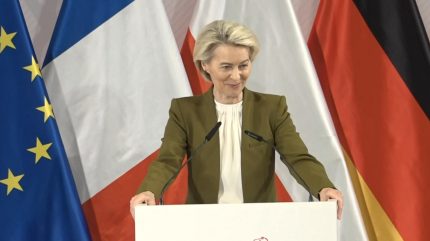
As elections for the European Parliament draw closer ahead of the opening of polls on 6 June 2024, the head of the European Commission, President Ursula von der Leyen, has said that the continent of Europe can only be considered a sovereign region if it “can defend itself” amid the backdrop of Russia’s ongoing war in Ukraine.
In a speech intended to mark the award to French President Emmanuel Macron’s of the International Peace of Westphalia Prize on 28 May, von der Leyen took the opportunity to once again press for a European defence union as an obvious continuation of the European political union set up decades ago.

Discover B2B Marketing That Performs
Combine business intelligence and editorial excellence to reach engaged professionals across 36 leading media platforms.
Von der Leyen, in her speech, claimed that Europe was “moving towards more sovereignty in the realm of defence” as countries seek to reestablish defence capabilities in the wake of Russia’s 2022 invasion of Ukraine.
“The past few years have clearly shown us that if we want to defend peace on our continent, we have to develop our own European might. And that is precisely why it is right and proper that defence budgets in Europe are growing and we are investing more in our defence industry,” said von der Leyen.
“For this reason, work on a European defence union is also appropriate. The initiative for an air defence shield is an illustration of this new European mission.”
Von der Leyen’s citing of ‘Europe’ refers to the 27 countries that are members of the European Union (EU), excluding non-EU or European Economic Area (EEA) countries such as the United Kingdom, Norway, Liechtenstein, and Iceland.
Of the latter four countries, only the UK is not a member of the EEA, which allows access to the EU’s Single Market in exchange for concessions on law and other matters.
EU elections: defence thrust front and centre
With Russia’s war in Ukraine ongoing the defence sector has been pushed to the front of the continent’s politics, with an emergent zeitgeist for an increasing in spending. European Union member states had increased national defence budgets by 20% from 2023, according to von der Leyen, speaking in February.
Nato also announced earlier this year that it expected 18 of its members to reach the 2% defence spend benchmark as a proportion of national GDP. Of the 32 Nato states, 30 of them are European countries, although not all are EU members, such as the UK and Türkiye.
The future composition of the European Parliament – to be determined in elections from 6-9 June – will play a significant role in the direction of travel for EU members in the coming years amid a rise in populist figureheads coming to power.
European Parliament groups such as the European People’s Party (EPP) broadly follow the same lines as von der Leyen, unsurprising given the EPP’s March nomination of von der Leyen as the lead Christian Democrat candidate for the European elections. The nomination is essential for the incumbent EC president to return to her post for the next term.
However, The Left Group in the European Parliament (GUE/NGL) takes an opposite view to European defence needs, posting an April 2024 blog titled ‘Weaponising influence: EU falls for arms lobby charm offensive’, calling out military spending amid a cost-of-living crisis.
EC echoes familiar themes on European defence
As former defence minister of Germany, von der Leyen has history in the sector, and has sought to rally the cause behind greater integration of European defence spending and eschew the current reliance on US capabilities.
However, von der Leyen’s period as German defence minister from 2013-2019 was not without controversy, as the Bundeswehr struggled for funding amid an equipment readiness crisis, turning up to one Nato exercise with painted broom handles in place of vehicle-mounted machine guns.
In a speech at the European Parliament Plenary on 28 February, von der Leyen said member states should increase collaboration in defence spending as the EU looks to become a more independent actor on the global stage.
Referencing the need to “rebuild, replenish, and modernise” military capabilities among member states’ armed forces, von der Leyen said that Europe should “strive to win the next generation of battle winning operational capabilities” through a “turbocharging” of the defence industrial capacity over the next five years.
Initiatives such as the European Industrial Defence Strategy, along with the European Defence Investment Programme, are some of the structures through which EU and EC leaders will look to drive greater integration.
Current EU collaborative defence programmes are generally of a modest nature, such as the 6×6 CAVS platform on land, or the European Patrol Corvette at sea. Germany and France are also working to develop a new main battle tank (MBT) to replace their Leopard 2 and Leclerc MBTs, although this has achieved little progress since its launch in 2017.
Historically, bilateral and multilateral defence programmes, driven by the countries themselves rather than at the supranational level, have had greater success in European defence procurement, as seen with platforms like the UK-German-Italian-Spanish Eurofighter or French-Italian FREMM frigates.






